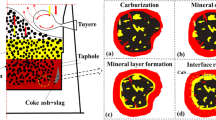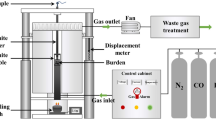Abstract
A variety of techniques, such as chemical analysis, scanning electron microscopy−energy dispersive spectroscopy, and X-ray diffraction, were applied to characterize the adhesion protective layer formed below the blast furnace taphole level when a certain amount of titanium- bearing burden was used. Samples of the protective layer were extracted to identify the chemical composition, phase assemblage, and distribution. Furthermore, the formation mechanism of the protective layer was determined after clarifying the source of each component. Finally, a technical strategy was proposed for achieving a stable protective layer in the hearth. The results show that the protective layer mainly exists in a bilayer form in the sidewall, namely, a titanium-bearing layer and a graphite layer. Both the layers contain the slag phase whose major crystalline phase is magnesium melilite (Ca2MgSi2O7) and the main source of the slag phase is coke ash. It is clearly determined that solid particles such as graphite, Ti(C,N) and MgAl2O4 play an important role in the formation of the protective layer, and the key factor for promoting the formation of a stable protective layer is reasonable control of the evolution behavior of coke.
Similar content being viewed by others
References
Z.J. Liu, J.L. Zhang, H.B. Zuo, and T.J. Yang, Recent progress on long service life design of Chinese blast furnace hearth, ISIJ Int., 52(2012), No. 10, p. 1713.
S.R. Zhang, Ironmaking progress in Chinese, [in] The 5th International Congress on the Science and Technology of Ironmaking, Shanghai, 2009.
H.B. Luengen and P. Michael, Ironmaking progress in Western Europe, [in] The 5th International Congress on the Science and Technology of Ironmaking, Shanghai, 2009.
J. Li, Z.T. Zhang, L.L. Liu, W.L. Wang, and X.D. Wang, Influence of basicity and TiO2 content on the precipitation behavior of the Ti-bearing blast furnace slags, ISIJ Int., 53(2013), No. 10, p. 1696.
H.B. Zhao, S.S. Cheng, and M.G. Zhao, Analysis of all-carbon brick bottom and ceramic cup synthetic hearth bottom, J. Iron Steel Res. Int., 14(2007), No. 2, p. 6.
R. Van Laar, E. Van Stein Callenfels, and M. Geerdes, Blast furnace hearth management for safe and long campaigns, Iron Steelmaker, 30(2003), No. 8, p. 123.
S.S. Cheng, T.J. Yang, Q.G. Xue, H.B. Zuo, X.W. Gao, and W.G. Yang, Numerical simulation for the lower shaft and the hearth bottom of blast furnace, J. Univ. Technol. Bei**g, 10(2003), No. 3, p. 16.
X.F. Lei and X.X. Xue, Preparation, characterization and photocatalytic activity of sulfuric acid-modified titanium-bearing blast furnace slag, Trans. Nonferrous Met. Soc. China, 20(2010), No. 12, p. 2294.
C.H. Lin, W.T. Cheng, and S.W. Du, Numerical prediction on the variation of temperature in the eroded blast furnace hearth with titanium dioxide in hot metal, Int. Commun. Heat Mass Transfer, 36(2009), No. 4, p. 335.
L. Zhang, L.N. Zhang, M.Y. Wang, G.Q. Li, and Z.T. Sui, Recovery of titanium compounds from molten Ti-bearing blast furnace slag under the dynamic oxidation condition, Miner. Eng., 20(2007), No. 7, p. 684.
R. Benesch, A. Le dzki, R. Kopec, and R. Stachura, Investigations into titanium distribution between metal and slag in liquid phases, Thermochim. Acta, 152(1989), No. 2, p. 433.
C.L. Fan, H. He, K.H. Zhang, and S.C. Han, Structural developments of artificial graphite scraps in further graphitization and its relationships with discharge capacity, Electrochim. Acta, 75(2012), p. 311.
L.H. Zou, B.Y. Huang, Y. Huang, Q.Z. Huang, and C.A. Wang, An investigation of heterogeneity of the degree of graphitization in carbon–carbon composites, Mater. Chem. Phys., 82(2003), No. 3, p. 654.
S. Gupta, D. French, R. Sakurovs, M. Grigore, H. Sun, T. Cham, T. Hilding, M. Hallin, B. Lindblom, and V. Sahajwalla, Minerals and iron-making reactions in blast furnaces, Prog. Energy Combust. Sci., 34(2008), No. 2, p. 155.
S.T. Cham, V. Sahajwalla, and R. Sakurovs, The dissolution of cokes in molten iron, [in] 21th Annual International Pittsburgh Coal Conference, Osaka, 2004.
J. Brännbacka and H. Saxén, Novel model for estimation of liquid levels in the blast furnace hearth, Chem. Eng. Sci., 59(2004), No. 16, p. 3423.
X.Q. Wang, Smelting of Vanadium and Titanium Magnetite in Blast Furnace, Metallurgical Industry Press, Bei**g, 1994.
K. Datta, P.K. Sen, and S.S. Gupta, Effect of titanium on the characteristics of blast furnace slags, Steel Res., 64(1993), No. 5, p. 232.
Z.Y. Chen, X. Zhang, and D.G. Yang, Electrochemical corrosion of carbon-containing refractories, J. Chin. Ceram. Soc., 15(1991), p. 442.
Author information
Authors and Affiliations
Corresponding author
Rights and permissions
About this article
Cite this article
Jiao, Kx., Zhang, Jl., Liu, Zj. et al. Formation mechanism of the protective layer in a blast furnace hearth. Int J Miner Metall Mater 22, 1017–1024 (2015). https://doi.org/10.1007/s12613-015-1163-2
Received:
Revised:
Accepted:
Published:
Issue Date:
DOI: https://doi.org/10.1007/s12613-015-1163-2




